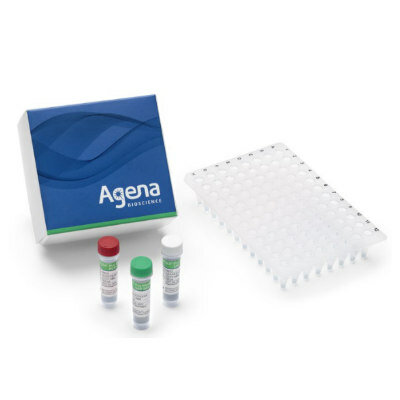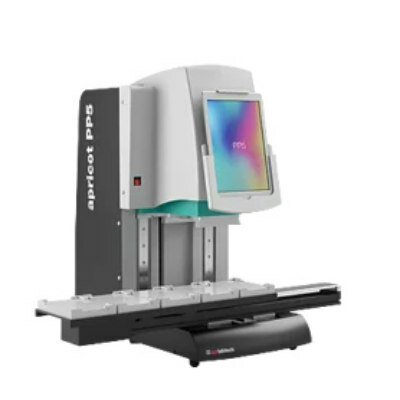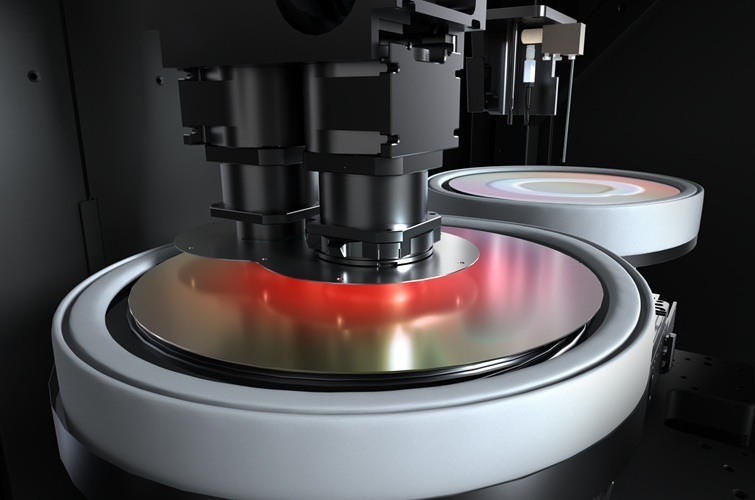Paper Diagnostic Directly Measures Fibrinogen in Whole Blood
|
By LabMedica International staff writers Posted on 10 Nov 2020 |
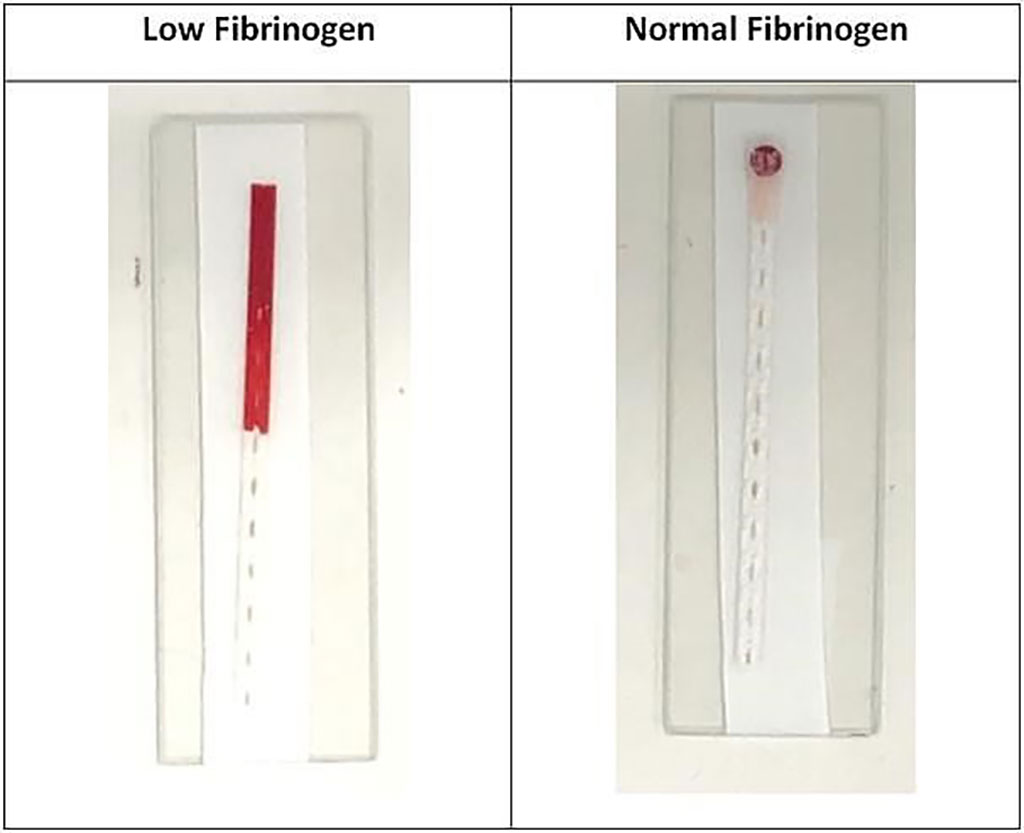
Image: Fibrinogen Test: people with low fibrinogen levels show a rapid movement of blood up the device (Photo courtesy of Monash University).
Fibrinogen is a protein found in blood that is needed for clotting. When a patient experiences traumatic injury, such as a serious car accident, or major surgery and childbirth complications, fibrinogen is required in their blood to prevent major hemorrhaging and death from blood loss.
Typically, heavily bleeding patients must be transported to a hospital or emergency center where they undergo diagnostic tests before being treated. These tests are time consuming and costly as they require expensive equipment, specialized or trained personnel and can take up to half an hour. More than 20% of major trauma patients have hyperfibrinogenemia.
Chemical Engineers at Monash University (Clayton, Australia) developed a handheld fibrinogen diagnostic device that works with whole blood. The test works by placing a pre-mixed droplet of a blood sample and an enzyme solution onto a solid surface, allowing it to clot, and then dropping a paper strip on top. The further that blood moves down the strip of paper, the lower the fibrinogen concentration. The diagnostic can work with a variety of blood conditions. Furthermore, diluting blood samples not only increases the test's sensitivity, but also eliminates the effect of interfering substances in the blood.
The further that blood moves down the strip, the lower the fibrinogen concentration. The diagnostic can easily measure plasma fibrinogen concentrations below 1.6 g/L for blood samples with hematocrits between 40 and 50%. The test can be completed in 3 to 4 minutes, making it suitable for diagnosing early hypofibrinogenemia and allowing for fibrinogen replacement therapy in critically bleeding patients.
Gil Garnier, PhD, a Professor of Chemical Engineering and senior author of the study, said, “This diagnostic will allow emergency doctors and paramedics to quickly and accurately diagnose low levels of fibrinogen in patients, giving them faster access to life-saving treatment to stop critical bleeding. When a patient is bleeding heavily and has received several blood transfusions, their levels of fibrinogen drop. Even after dozens of transfusions, patients keep bleeding. What they need is an injection of fibrinogen. However, if patients receive too much fibrinogen, they can also die.” The study was published on October 23, 2020 in the journal ACS Sensors.
Related Links:
Monash University
Typically, heavily bleeding patients must be transported to a hospital or emergency center where they undergo diagnostic tests before being treated. These tests are time consuming and costly as they require expensive equipment, specialized or trained personnel and can take up to half an hour. More than 20% of major trauma patients have hyperfibrinogenemia.
Chemical Engineers at Monash University (Clayton, Australia) developed a handheld fibrinogen diagnostic device that works with whole blood. The test works by placing a pre-mixed droplet of a blood sample and an enzyme solution onto a solid surface, allowing it to clot, and then dropping a paper strip on top. The further that blood moves down the strip of paper, the lower the fibrinogen concentration. The diagnostic can work with a variety of blood conditions. Furthermore, diluting blood samples not only increases the test's sensitivity, but also eliminates the effect of interfering substances in the blood.
The further that blood moves down the strip, the lower the fibrinogen concentration. The diagnostic can easily measure plasma fibrinogen concentrations below 1.6 g/L for blood samples with hematocrits between 40 and 50%. The test can be completed in 3 to 4 minutes, making it suitable for diagnosing early hypofibrinogenemia and allowing for fibrinogen replacement therapy in critically bleeding patients.
Gil Garnier, PhD, a Professor of Chemical Engineering and senior author of the study, said, “This diagnostic will allow emergency doctors and paramedics to quickly and accurately diagnose low levels of fibrinogen in patients, giving them faster access to life-saving treatment to stop critical bleeding. When a patient is bleeding heavily and has received several blood transfusions, their levels of fibrinogen drop. Even after dozens of transfusions, patients keep bleeding. What they need is an injection of fibrinogen. However, if patients receive too much fibrinogen, they can also die.” The study was published on October 23, 2020 in the journal ACS Sensors.
Related Links:
Monash University
Latest Hematology News
- New Scoring System Predicts Risk of Developing Cancer from Common Blood Disorder
- Non-Invasive Prenatal Test for Fetal RhD Status Demonstrates 100% Accuracy
- WBC Count Could Predict Severity of COVID-19 Symptoms
- New Platelet Counting Technology to Help Labs Prevent Diagnosis Errors
- Streamlined Approach to Testing for Heparin-Induced Thrombocytopenia Improves Diagnostic Accuracy
- POC Hemostasis System Could Help Prevent Maternal Deaths
- New Test Assesses Oxygen Delivering Ability of Red Blood Cells by Measuring Their Shape
- Personalized CBC Testing Could Help Diagnose Early-Stage Diseases in Healthy Individuals
- Non-Invasive Test Solution Determines Fetal RhD Status from Maternal Plasma
- First-Of-Its-Kind Smartphone Technology Noninvasively Measures Blood Hemoglobin Levels at POC

- Next Gen CBC and Sepsis Diagnostic System Targets Faster, Earlier, Easier Results
- Newly Discovered Blood Group System to Help Identify and Treat Rare Patients
- Blood Platelet Score Detects Previously Unmeasured Risk of Heart Attack and Stroke
- Automated Benchtop System to Bring Blood Testing To Anyone, Anywhere
- New Hematology Analyzers Deliver Combined ESR and CBC/DIFF Results in 60 Seconds
- Next Generation Instrument Screens for Hemoglobin Disorders in Newborns
Channels
Clinical Chemistry
view channel
‘Brilliantly Luminous’ Nanoscale Chemical Tool to Improve Disease Detection
Thousands of commercially available glowing molecules known as fluorophores are commonly used in medical imaging, disease detection, biomarker tagging, and chemical analysis. They are also integral in... Read more
Low-Cost Portable Screening Test to Transform Kidney Disease Detection
Millions of individuals suffer from kidney disease, which often remains undiagnosed until it has reached a critical stage. This silent epidemic not only diminishes the quality of life for those affected... Read more
New Method Uses Pulsed Infrared Light to Find Cancer's 'Fingerprints' In Blood Plasma
Cancer diagnoses have traditionally relied on invasive or time-consuming procedures like tissue biopsies. Now, new research published in ACS Central Science introduces a method that utilizes pulsed infrared... Read moreMolecular Diagnostics
view channel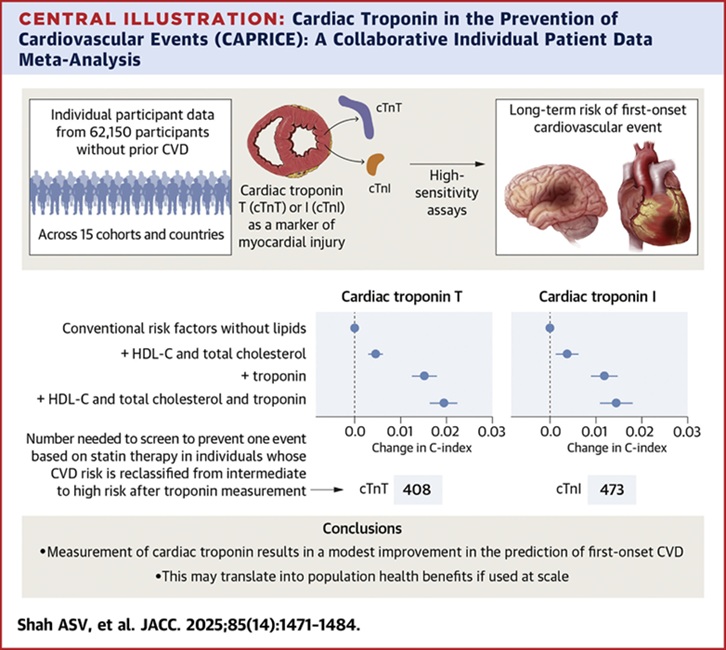
Simple Blood Test Improves Heart Attack and Stroke Risk Prediction
Troponin is a protein found in heart muscle cells that is released into the bloodstream when the heart is damaged. High-sensitivity troponin blood tests are commonly used in hospitals to diagnose heart... Read more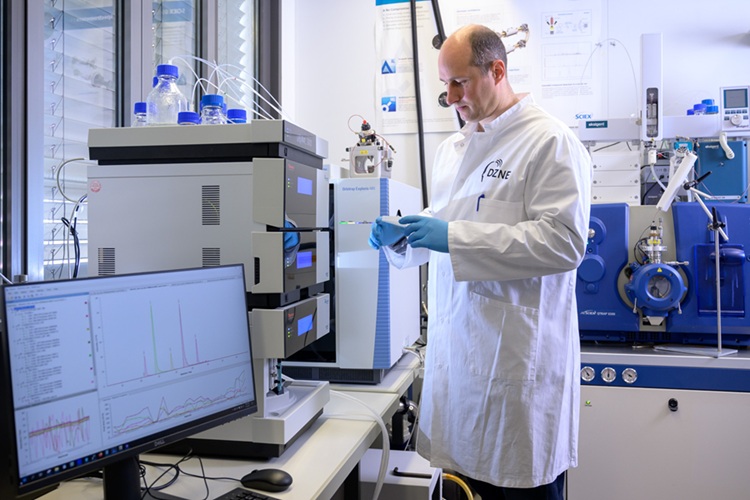
Blood Biomarker Test Could Detect Genetic Predisposition to Alzheimer’s
New medications for Alzheimer’s disease, the most common form of dementia, are now becoming available. These treatments, known as “amyloid antibodies,” work by promoting the removal of small deposits from... Read more
Novel Autoantibody Against DAGLA Discovered in Cerebellitis
Autoimmune cerebellar ataxias are strongly disabling disorders characterized by an impaired ability to coordinate muscle movement. Cerebellar autoantibodies serve as useful biomarkers to support rapid... Read more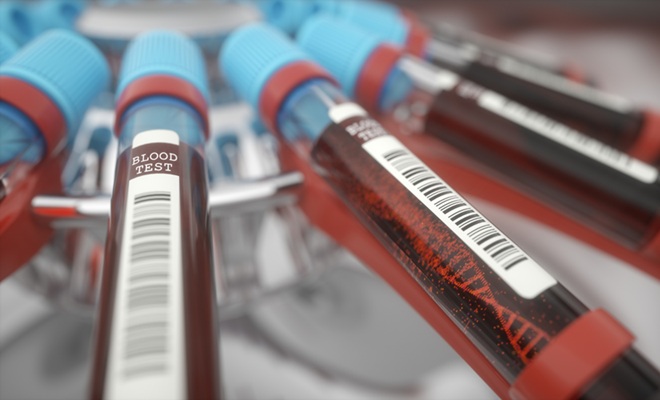
Gene-Based Blood Test Accurately Predicts Tumor Recurrence of Advanced Skin Cancer
Melanoma, an aggressive form of skin cancer, becomes extremely difficult to treat once it spreads to other parts of the body. For patients with metastatic melanoma tumors that cannot be surgically removed... Read moreImmunology
view channel
Stem Cell Test Predicts Treatment Outcome for Patients with Platinum-Resistant Ovarian Cancer
Epithelial ovarian cancer frequently responds to chemotherapy initially, but eventually, the tumor develops resistance to the therapy, leading to regrowth. This resistance is partially due to the activation... Read more
Machine Learning-Enabled Blood Test Predicts Immunotherapy Response in Lymphoma Patients
Chimeric antigen receptor (CAR) T-cell therapy has emerged as one of the most promising recent developments in the treatment of blood cancers. However, over half of non-Hodgkin lymphoma (NHL) patients... Read moreMicrobiology
view channel
Handheld Device Delivers Low-Cost TB Results in Less Than One Hour
Tuberculosis (TB) remains the deadliest infectious disease globally, affecting an estimated 10 million people annually. In 2021, about 4.2 million TB cases went undiagnosed or unreported, mainly due to... Read more
New AI-Based Method Improves Diagnosis of Drug-Resistant Infections
Drug-resistant infections, particularly those caused by deadly bacteria like tuberculosis and staphylococcus, are rapidly emerging as a global health emergency. These infections are more difficult to treat,... Read more
Breakthrough Diagnostic Technology Identifies Bacterial Infections with Almost 100% Accuracy within Three Hours
Rapid and precise identification of pathogenic microbes in patient samples is essential for the effective treatment of acute infectious diseases, such as sepsis. The fluorescence in situ hybridization... Read morePathology
view channel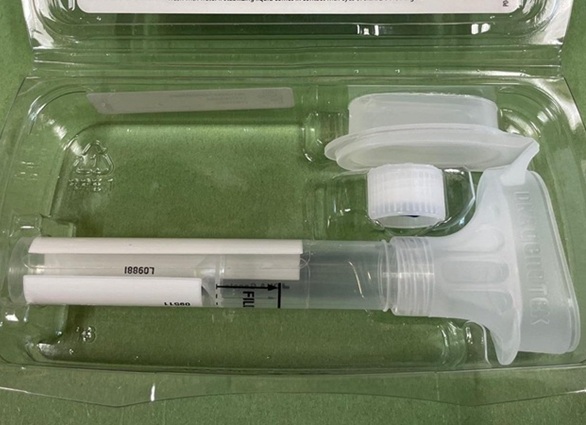
Spit Test More Accurate at Identifying Future Prostate Cancer Risk
Currently, blood tests that measure the level of a protein called prostate-specific antigen (PSA) are commonly used to identify men at higher risk for prostate cancer. This test is typically used based... Read moreDNA Nanotechnology Boosts Sensitivity of Test Strips
Since the Covid-19 pandemic, most people have become familiar with paper-based rapid test strips, also known as lateral flow immunoassays (LFIAs). These tests are used to quickly detect biomarkers that... Read more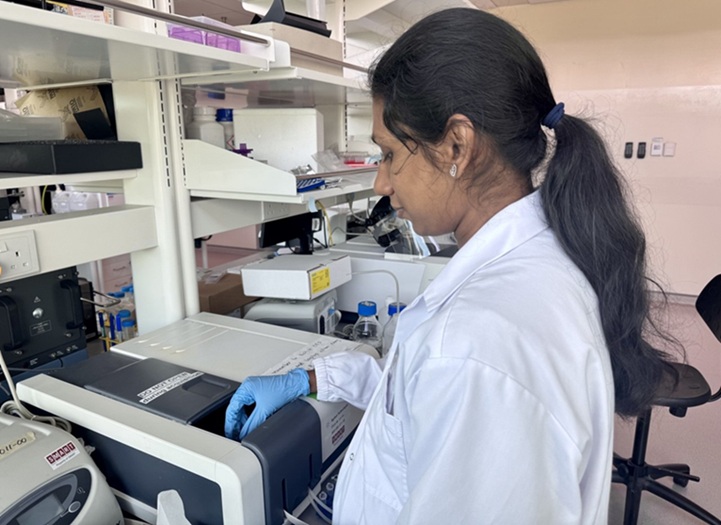
Novel UV and Machine Learning-Aided Method Detects Microbial Contamination in Cell Cultures
Cell therapy holds great potential in treating diseases such as cancers, inflammatory conditions, and chronic degenerative disorders by manipulating or replacing cells to restore function or combat disease.... Read moreTechnology
view channel
Disposable Microchip Technology Could Selectively Detect HIV in Whole Blood Samples
As of the end of 2023, approximately 40 million people globally were living with HIV, and around 630,000 individuals died from AIDS-related illnesses that same year. Despite a substantial decline in deaths... Read more
Pain-On-A-Chip Microfluidic Device Determines Types of Chronic Pain from Blood Samples
Chronic pain is a widespread condition that remains difficult to manage, and existing clinical methods for its treatment rely largely on self-reporting, which can be subjective and especially problematic... Read more
Innovative, Label-Free Ratiometric Fluorosensor Enables More Sensitive Viral RNA Detection
Viruses present a major global health risk, as demonstrated by recent pandemics, making early detection and identification essential for preventing new outbreaks. While traditional detection methods are... Read moreIndustry
view channel
Cepheid and Oxford Nanopore Technologies Partner on Advancing Automated Sequencing-Based Solutions
Cepheid (Sunnyvale, CA, USA), a leading molecular diagnostics company, and Oxford Nanopore Technologies (Oxford, UK), the company behind a new generation of sequencing-based molecular analysis technologies,... Read more
Grifols and Tecan’s IBL Collaborate on Advanced Biomarker Panels
Grifols (Barcelona, Spain), one of the world’s leading producers of plasma-derived medicines and innovative diagnostic solutions, is expanding its offer in clinical diagnostics through a strategic partnership... Read more




